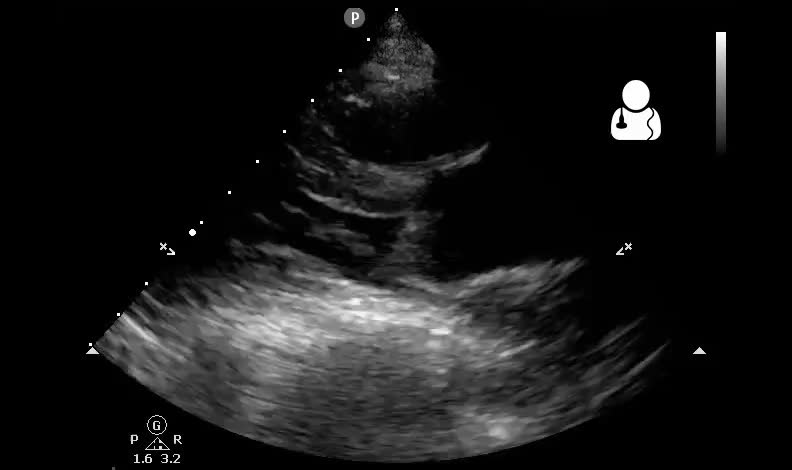78 y/o female with a history of CAD, cirrhosis, DM, and HTN presents with left arm pain, chest pain, and post-prandial dyspnea on exertion. Physical exam is unremarkable, except for an elevated blood pressure of 195/78. Troponin is negative and the EKG is unremarkable. Prior to obtaining a CT scan, bedside ultrasound is performed, revealing the following images.

Diagnosis: Large Hiatal Hernia
Bedside ultrasound demonstrated a fluid filled, occasionally peristalsing structure above the diaphragm, that had the appearance of the stomach. This structure was found to be abutting the left atrium when an echo was performed. A CT, shown below, confirmed the findings.
- Hiatal hernias (HH) come in three varieties: Type I is the classic sliding hernia which
 accounts for 95% of all hiatal hernias. Type II is the paraesophageal hernia, Type III is a mixture of types I and II, and type IV is when there is herniation of other abdominal contents into the posterior mediastinum.1
accounts for 95% of all hiatal hernias. Type II is the paraesophageal hernia, Type III is a mixture of types I and II, and type IV is when there is herniation of other abdominal contents into the posterior mediastinum.1 - Hiatal hernias can cause the gastroesophageal junction to become incompetent, increasing the incidence of GERD. 1
- Ultrasound (US) has been shown to be a promising adjunct study in the evaluation of a patient with a hiatal hernia. One study found ultrasound to have a PPV of 82.7% and a NPV of 97% in the detection of HH. 2
- Ultrasound has also been shown to have a high correlation with CT diagnosis of HH. One study found an agreement of 0.995 between the two imaging modalities.3
- HH should be on the differential in a patient with chest pain,4 and in fact syncope due to compression of the LA from a large HH has been described, as we saw in our patient.5
- Hyun JJ, Bak YT. Clinical significance of hiatal hernia. Gut Liver. 2011;5:(3)267-77. [pubmed]
- Barone M, Di Lernia P, Carbonara M, et al. Sliding gastric hiatal hernia diagnosis by transabdominal ultrasonography: an easy, reliable and non-invasive procedure. Scand J Gastroenterol. 2006;41:(7)851-5. [pubmed]
- Cakmakci E, Celebi I, Tahtabasi M, et al. Accuracy of ultrasonography in the diagnosis of sliding hiatal hernias. Acad Radiol. 2013;20:(4)453-6. [pubmed]
- Koskinas KC, Oikonomou K, Karapatsoudi E, Makridis P. Echocardiographic manifestation of hiatus hernia simulating a left atrial mass: case report. Cardiovasc Ultrasound. 2008;6:46. [pubmed]
- Oishi Y, Ishimoto T, Nagase N, et al. Syncope upon swallowing caused by an esophageal hiatal hernia compressing the left atrium: a case report. Echocardiography. 2004;21:(1)61-4. [pubmed]




